verilog language-module hierarchy
作者:互联网
Problem 19:Module
注意到程序开头都是 module,意味着我们写的程序都是一个模块电路
模块与模块之间构成了层级。
模块例化的基本语法:

module mod_a ( input in1, input in2, output out );//
// Module body
endmodule
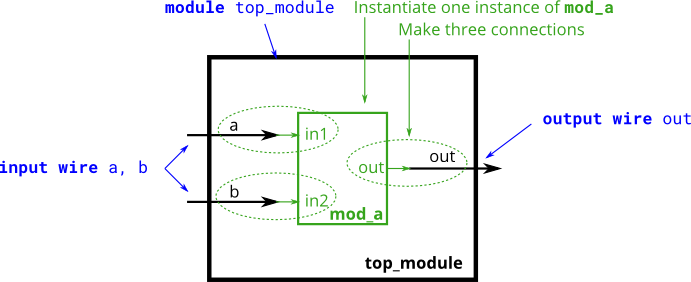
顶层模块的下层模块 mod_a 相当于一个黑盒子,里面什么东西并不重要,重要的是输入输出端口。
模块信号连接的两种方式
-
按端口顺序
mod_a instance1(wa,wb,wc);//模块名 实例名(定义连接 port 的信号 //wa,wb,wc分别连接到模块的第一个端口(in1),第二个端口(in2),第三个端口(out)。这里的端口顺序指的是模块端口的定义顺序,一旦端口列表顺序发生改变,所有模块中的实例化中的端口都需要改变
-
按端口名称连接端口
mod_a instance1(.out(wc),.in1(wa),.in2(wb));//根据端口名称指定外部信号的连接,和端口定义的顺序完全没有关系
module top_module ( input a, input b, output out );
mod_a U_mod_a(
.in1(a)
, .in2(b)
, .out(out));
//mod_a U_mod_a(a, .b, out); //使用按照端口顺序的方式 声明信号连接
endmodule
Problem 20: Connecting ports by position(Module pos)
给出一个 4 输入,2 输出的 mod_a 模块、
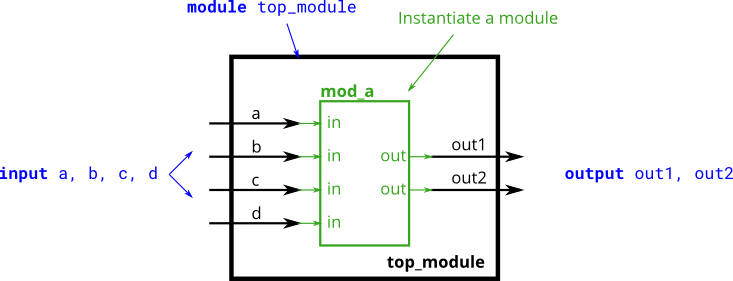
给出的模块如下:
module mod_a ( output, output, input, input, input, input );//只标注输入输出端口而没有名字是不规范的,应该要赋予每个端口一个名字
module top_module (
input a,
input b,
input c,
input d,
output out1,
output out2
);
mod_a name(out1,out2,a,b,c,d);//这里题目并没有给出输入输出端口的名字,所以只能按照顺序来连接
endmodule
Problem 21:Connecting ports by name(Module name)
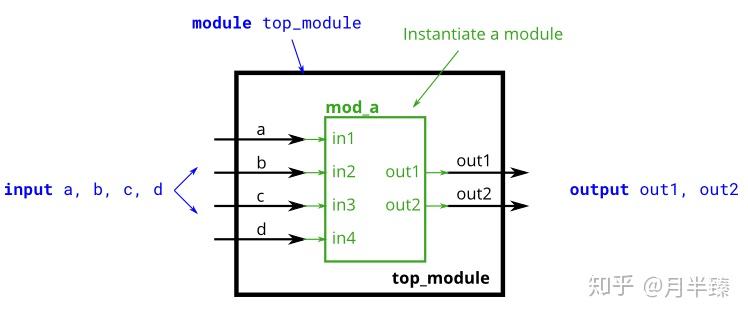
给出的模块如下:
module mod_a ( output out1, output out2, input in1, input in2, input in3, input in4);//这里给出了每个端口的名称
module top_module (
input a,
input b,
input c,
input d,
output out1,
output out2
);
mod_a name(
.out1(out1),
.out2(out2),
.in1(a),
.in2(b),
.in3(c),
.in4(d));//这里按照模块端口名称进行连接,可以不用按顺序
endmodule
但如果按题目给出的顺序写成如下,会报错:
mod_a name(out1,out2,a,b,c,d);
(猜测是因为题目给的模块顺序发生的改变,不知道内部什么结构,所以有点难调)
Problem 22:Three modules(Module shift)

给出一个名为 my_dff 的模块,包含两个输入和一个输出
module my_dff ( input clk, input d, output q );
module top_module ( input clk, input d, output q );
wire m,n;
my_dff name1(.clk(clk),.d(d),.q(m));//对my_dff进行了三次实例化,用了三个不同的名字(name1,name2,name3)
my_dff name2(.clk(clk),.d(m),.q(n));//端口用了名称定义的方式,建议少用顺序定义的方式
my_dff name3(.clk(clk),.d(n),.q(q));
endmodule
Problem 23:Module and vectors(Module shift8)
向量可以代替单根连接线作为模块的端口,在连接的时候也是向量连接,而不是单根导线
当端口的向量长度和连接的导线不匹配时,会导致向量的零填充或截断,

给出一个模块,包含两个输入和一个输出,实现一个 8bit 的 D 触发器。实例化三个模块,并连接在一起,形成一个长度为 3 的 8bit 的移位寄存器。
再加入一个 4 选 1 多路复用器,根据输入的 sel[1:0]选择要输出的内容:输入 D 的值,第一个 D 触发器之后的值……相当于是选择输入延迟的周期数,0~3 个时钟周期不等
给出:
module my_dff8 ( input clk, input [7:0] d, output [7:0] q );
实现:
module top_module (
input clk,
input [7:0] d,
input [1:0] sel,
output reg [7:0] q
);
wire [7:0] o1, o2, o3; // 声明每一个触发器的输出
// Instantiate three my_dff8s
my_dff8 d1 ( clk, d, o1 );
my_dff8 d2 ( clk, o1, o2 );
my_dff8 d3 ( clk, o2, o3 );
// 这是实现4选1选择器的一种方法
always @(*) // 组合逻辑always块
case(sel)
2'h0: q = d;
2'h1: q = o1;
2'h2: q = o2;
2'h3: q = o3;
endcase
endmodule
Problem 24:Adder 1 (Module add)
给出一个 16bit 加法器模块 add16,实例化两个 add16 以达到 32bit 加法器。
原理:一个 add16 模块计算结果的低 16 位,另一个 add16 模块接受第一个的进位后计算结果的高 16 位。
给出:
module add16 ( input[15:0] a, input[15:0] b, input cin, output[15:0] sum, output cout );
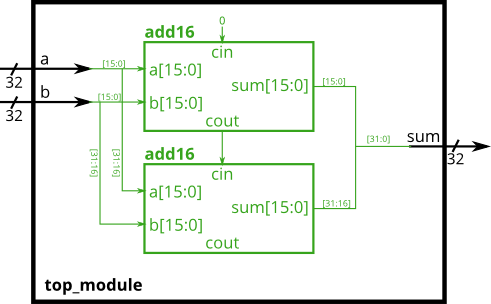
module top_module(
input [31:0] a,
input [31:0] b,
output [31:0] sum
);
wire cout;
add16 c1(.a(a[15:0])
,.b(b[15:0])
,.cin(0)
,.sum(sum[15:0])
,.cout(cout)
);
add16 c2(.a(a[31:16])
,.b(b[31:16])
,.cin(cout)
,.sum(sum[31:16])
,.cout()
);
endmodule
Problem 25:Adder 2(Module fadd)
描述一个具有两级层次结构的电路,实例化两个 add16 模块,每个 add16 中实例化 16 个 add1 实例。
给出:
module add16 ( input[15:0] a, input[15:0] b, input cin, output[15:0] sum, output cout );
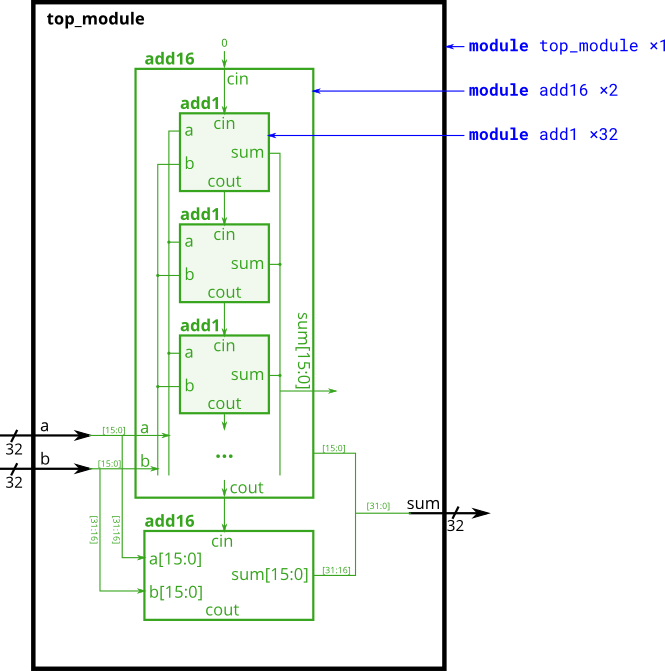
在每个 add16 中,实例化了 16 个全加器去执行加法操作,需要自己编写并声明。
全加器的逻辑表达式
实现
module top_module (
input [31:0] a,
input [31:0] b,
output [31:0] sum
);//
wire carry;
add16 a1(.a(a[15:0])
,.b(b[15:0])
,.cin(0)
,.sum(sum[15:0])
,.cout(carry)
);
add16 a2(.a(a[31:16])
,.b(b[31:16])
,.cin(carry)
,.sum(sum[31:16])
,.cout()
);
endmodule
module add1 ( input a, input b, input cin,output sum, output cout );
// Full adder module here
assign sum=a^b^cin;
assign cout=(a&b)|(a&cin)|(b&cin);
endmodule
Problem 26:Carry-select adder(Module cseladd)
上面一个实现的加法器叫做行波进位加法器(RCA:Ripple-Carry Adder)
这种加法器的缺点:计算进位输出延迟比较大。
改进该加法器:第一级加法器保持不变,第二个加法器实现两个,一个假设进位为 0,另一个假设进位为 1,然后用第一级结果和 2 选 1 选择器来选择哪一种结果是正确的。

给出 add16 模块:
module add16 ( input[15:0] a, input[15:0] b, input cin, output[15:0] sum, output cout );
实现:
module top_module(
input [31:0] a,
input [31:0] b,
output [31:0] sum
);
wire carry;
wire [31:16] sum0,sum1;
add16 c1(.a(a[15:0])
,.b(b[15:0])
,.cin(0)
,.sum(sum[15:0])
,.cout(carry)
);
add16 c2(.a(a[31:16])
,.b(b[31:16])
,.cin(0)
,.sum(sum0[31:16])
,.cout());
add16 c3(.a(a[31:16])
,.b(b[31:16])
,.cin(1)
,.sum(sum1[31:16])
,.cout());
assign sum[31:16]=carry?sum1:sum0;
endmodule
以上是进位加法器(CSA:Carry-Select Adder),对比上一题的行波进位,加法器延迟小一半,但增多了 50% 的逻辑资源。
Problem 27:Adder–subtractor (Module addsub)
加减法器可以通过加法器去实现,对其中一个数取相反数(对输入数据取反,然后加 1)。
最终结果是一个可以执行以下两个操作的电路:a+b+0 和 a+~ b+1
给出 16bit 加法器模块:
module add16 ( input[15:0] a, input[15:0] b, input cin, output[15:0] sum, output cout );
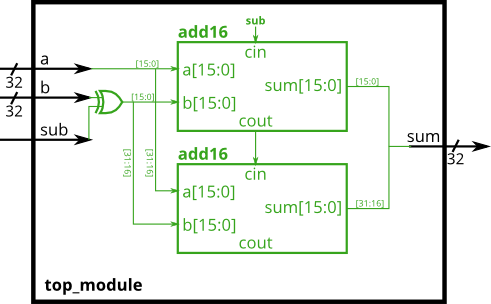
module top_module(
input [31:0] a,
input [31:0] b,
input sub,
output [31:0] sum
);
wire carry;
wire [31:0]b1;
assign b1=b^{32{sub}};//当sub=1时,使用32位的异或门对B进行取反
add16 c1(.a(a[15:0])
,.b(b1[15:0])
,.cin(sub)
,.sum(sum[15:0])
,.cout(carry)
);
add16 c2(.a(a[31:16])
,.b(b1[31:16])
,.cin(carry)
,.sum(sum[31:16])
,.cout()
);
endmodule
- 减去一个数等于加上这个数的补码(代码中的按位取反再加 1)
标签:15,hierarchy,31,module,verilog,output,input,sum 来源: https://www.cnblogs.com/zjj666/p/15614833.html